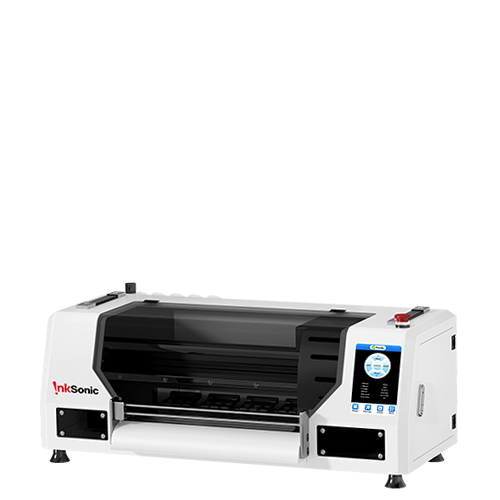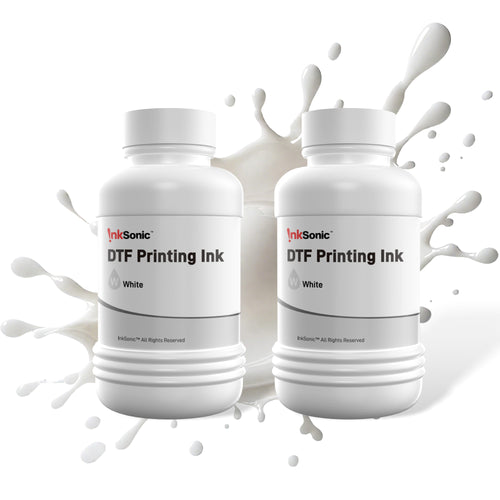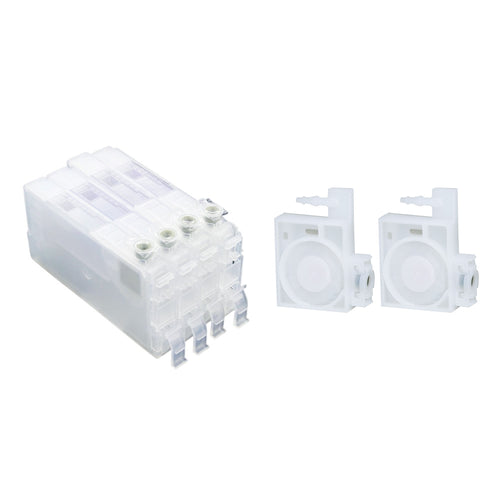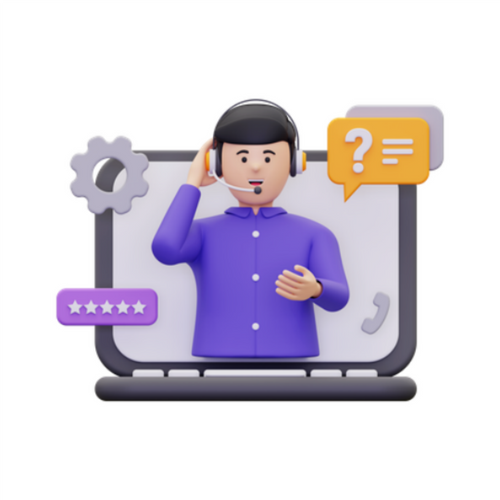You’ve spent late nights sketching designs that you can already picture on T-shirts, hoodies, tote bags — maybe even hats. Friends keep telling you to “just launch your shop already.” You know there’s a market out there that would love your style.
But now you’re staring at two different paths.
On one side, there’s POD (print on demand): low risk, no equipment to buy, and your designs can be online in hours. But the trade-off? Lower profit margins, generic packaging, and less control over print quality and shipping speed.
On the other side, there’s investing in a DTF printer for small business — which suddenly puts real production power in your hands. You’d keep more profit per shirt, experiment with special finishes, and control your customer experience from print to package. Yet it’s a big step: higher upfront cost, a learning curve, and the responsibility of fulfillment.
It’s not an easy choice. Your heart says “build something real and unique,” while your head worries about cost and risk. So, which path truly fits your goals, budget, and creative vision? Let’s break down the numbers, pros and cons, and hidden realities of both — so you can decide with confidence.

Option 1: POD Platform – What the Numbers Really Look Like
Starting your custom T-shirt business with a POD (Print on Demand) platform is appealing for a reason — the barrier to entry is almost zero. You could theoretically start with as little as $0 if you already have designs, because you don’t need to pre-purchase shirts, inks, or equipment. Your biggest upfront investment is usually just your time: setting up an online store, uploading designs, and running ads or social media.
One huge advantage is no inventory risk . Statistics from Printify show that 35% of new sellers worry about unsold stock — a problem POD completely removes. You only produce what your customers buy. Plus, if your brand suddenly goes viral on TikTok, POD platform has the infrastructure to handle hundreds or thousands of orders overnight.
Another big plus is ease of use . Printful reports that 45% of their sellers start without any background in garment printing. You don’t need to master heat press settings, color calibration, or maintenance schedules. Your job is purely creative and promotional.
But these benefits of POD come with real trade-offs that many new POD sellers only discover after they launch .
Let’s start with profit margins. According to Printify’s profit calculator, if you list a T-shirt at $25 — a common price in the mid-tier custom apparel market — your base production cost alone can be $12–$14 , depending on the garment brand, color, and how large your print area is. And that’s before you even count platform fees, transaction fees from Shopify or Etsy (typically around 3–6%), and what you’ll likely spend on marketing, whether it’s Facebook ads, influencer samples, or even just boosted posts on Instagram. When all is said and done, your true net profit per shirt might only be around $6–$8 , often falling below 30% margin . This can make it hard to scale, offer discounts, or reinvest in your brand.
Then there’s customization — or rather, the lack of it. Most POD services are built around speed and standardization, so you’re usually limited to print on mass-produced blank garments. Want to add prints for festivals, or specialty placements like sleeve prints? Those options are typically unavailable or cost-prohibitive, which can leave your shop looking like dozens of others selling similar printed tees.

Control can be another source of frustration. A Shopify survey found that 20% of POD sellers say delayed shipments during peak seasons are their biggest headache . Since you do not ever get to actually see the product before you ship it, any errors — like off-center prints, wrong sizes, or color mis-matches — immediately fall into your customer feedback, damaging your brand reputation when it was not your fault.
Packaging too is generic: generic mailers, not branded tissue or thank-you cards, making it harder to create a premium unboxing experience. There's no way to showcase what makes your package special.
Finally, fulfillment times can feel slow in today’s “Amazon Prime” world. Printful, for instance, lists standard production times of 2–5 business days , which can extend to 7–10+ days during holidays before the order even ships. Customers used to fast delivery can become impatient, cancel orders, or leave lower ratings.
POD is amazing for launching quickly and testing new ideas with almost no upfront investment. But the cost of that convenience is often lower profits, limited creative freedom, and very little control over the final product and customer experience — all of which can matter more than you think when building a lasting brand.
Option 2: Buy a DTF Printer for Small Business – What It Really Means
Buying your own DTF printer for small business sounds like a big leap — and it is. But it’s also the choice that can transform your side hustle into a brand that feels truly yours.
First, let’s talk cost. A mid-range A3 DTF printer can cost around $3,000–$5,000 USD . Add a heat press ($500–$1,000), film, powder, ink, and cleaning supplies for about $500–$1,000. In total, start with roughly $4,000–$7,000 . It’s not pocket change, but it’s also less than the price of building out a full screen-print shop or leasing a DTG machine.
Where it gets interesting is profit per shirt . A blank cotton T-shirt (depending on brand and quality) might cost you $2–$4 in bulk. DTF consumables — ink, adhesive powder, film — typically add about $1–$2 per print. That means your total production cost per shirt can be just $3–$6 .

DTF has a learning curve. You’ll spend time maintaining print heads, managing color profiles, and troubleshooting jams or film issues. Some users report an extra 30–60 minutes a day for prep and maintenance. And unlike POD, if you get a spike in sales, you’ll need to keep up with production yourself — or hire help.
But the real power of investing in your own DTF printer for small business goes far beyond the numbers on a spreadsheet. It’s about something every creator secretly craves: control.
Picture this: a customer messages your shop late at night. They forgot to order a birthday shirt for the weekend, and they’re desperate. If you rely on POD, there’s nothing you can do — the production queue is out of your hands. But if you print in-house, you can walk over to your workspace, fire up your machine, and ship it the next morning. That flexibility doesn’t just save the order; it earns loyal fans who’ll tell their friends, “They came through when no one else could.”
Control also means catching small mistakes before they become big problems. Imagine noticing a typo on a design just as it’s about to print — you can fix it instantly. With POD, you’d likely discover it only after your customer opens the package, leading to refunds and bad reviews.
Beyond emergencies, owning your production lets you shape the customer experience . You can use higher-quality blanks that are softer to the touch or wear better. You can put personalized neck labels in, send shirts in branded tissue paper, add handwritten thank-you notes, or put discount cards in to use on future orders. All those little things turn a plain order into an unboxing experience customers brag about to their friends — and repeat.
And then there’s creativity — the real magic. With a DTF setup, you can design bold one-off prints, launch limited holiday drops overnight, or experiment with niche memes trending on social media. Want to test metallic foil or glow-in-the-dark pattern? You can. You’re no longer limited to what a POD catalog offers; your imagination becomes your only ceiling.

Finally, owning a printer unlocks local markets that POD simply can’t serve. Small cafés wanting branded aprons, school teams needing shirts for next week’s game, local events ordering 20–50 shirts — these are often too small or too urgent for POD. But they’re perfect for an agile local business with in-house production. Those jobs add steady cash flow, help you network locally, and keep your brand visible beyond the internet.
Having your own DTF printer isn’t just about higher margins. It’s about owning your brand story, delighting your customers, and turning creative ideas into real products on your terms — quickly, confidently, and authentically.
| Factor | POD | Own DTF |
| Initial capital | Low | Moderate–high |
| Control & flexibility | Low | High |
| Profit margin | Low–medium | High |
| Time investment | Low | High |
| Scalability | Easy | Limited by your production capacity |
Own Your Own DTF Printer: Build, Control, and Profit More from Your Brand
If you’re thinking about launching your custom T-shirt brand — or if you’ve already dipped your toes into POD — you’ve probably noticed something most guides don’t say out loud: profit margins, creative freedom, and brand identity matter far more than you think.
Design inspiration can come at any time. It's late at night and you've just come up with a new design that you think could be your next best-seller. Instead of uploading it to a POD platform and hoping the sample looks perfect, you walk over to your own DTF printer, press the button, and after printing and heat pressing, you get a real T-shirt. That's the difference between coming up with a product and making it yourself.
Here’s why investing in your own DTF printer isn’t just about buying equipment — it’s about transforming your business into something truly yours.

1. Higher profit margins = Keep more money per shirt
By producing it in-house, you can collect more profit from each shirt sold with the same promotional push. Years down the line, those extra dollars add up, helping you to invest in improved adverts, fresh designs, or even rent money — transforming your artistic work into a solid business.
2. Creative freedom & brand differentiation
Owning a DTF printer means your brand stands out visually, so your store doesn’t look like a copy of the dozens of POD stores selling the same stock designs.
You can print on dark cotton, polyester, canvas bags to your heart’s content – add metallics, neons, or even small batches of seasonal designs. Create a brand that is truly unique to you.
3. Faster fulfillment & happier customers
POD fulfillment can take 2–7 days before shipping even begins — longer during peak holiday season. Customers notice, especially in a world trained by Prime’s speed. With a DTF printer, you print and ship the same day.
By printing and mailing orders yourself, you're able to get products out the same day or even next day — surprising customers with speed that POD sites can't provide. This fast, reliable service earns 5-star ratings and repeat business, fostering trust and loyalty that money can't buy.
4. Serve local markets & custom orders
Local schools, sports teams, restaurants, and events often need 10–50 shirts quickly. POD platforms aren’t built for these small, urgent orders — but you are.
By owning a DTF printer, you can quickly produce small, custom orders for local teams, businesses, and events — something POD services can’t handle. These local jobs not only bring steady income but also boost your brand’s visibility through real-world word-of-mouth, reaching customers beyond online sales alone.
5. Low minimums = test ideas instantly
Have a new meme or holiday idea? POD usually makes you order samples or wait for approval. With DTF, you print a single shirt the same night inspiration strikes.
With your own DTF printing, you can make an individual sample to test new designs or trending memes on the fly — without waiting or extra cost. You get to experiment with speed, see what actually sells, and tweak your products before ordering in bulk.

6. Long-term cost savings & business asset
POD costs never disappear: every shirt forever carries that $12–$14 base cost. A DTF printer, on the other hand, is a one-time investment.
By investing in your own DTF printer, you avoid endless POD fees and start keeping more of each sale. After printing just a few hundred shirts, the machine pays for itself — and from then on, the profits go straight to you instead of your supplier.
7. Diversify products beyond T-shirts
Many POD catalogs are limited to shirts, hoodies, and mugs. But your DTF printer can handle cotton, blends, polyester, tote bags, aprons, hats — even shoes.
With DTF printing, you don't have to limit yourself to T-shirts only — you can easily include tote bags, hats, aprons, and even shoes in your product line. This makes your shop a full-fledged lifestyle brand with greater appeal.
8. Brand control & customer experience
POD sellers often feel invisible: generic packaging, no special touches. With your own production, you craft every detail.
By doing production yourself, you get to incorporate personalized packaging, thank-you cards, and special wrap that speak to your brand personality. These little details set your orders apart, turning one-time buyers into loyal followers who relate to your brand — not only the product.

Choosing InkSonic: More Than Just a DTF Printer
In the end, both POD and owning your own DTF printer can build a successful T-shirt business — but they fit different kinds of entrepreneurs. If you’re brand new, want ultra-low risk, and prefer to focus purely on design and marketing while someone else handles production and shipping, POD is a simple way to test ideas quickly. It’s ideal for creatives who value convenience over full control.
But if you’re serious about turning your brand into something unique — with better margins, faster delivery, and products that go beyond standard tees — then investing in your own DTF printer makes all the difference. It suits entrepreneurs who want to control quality, experiment freely, serve local customers, and keep more profit from every sale. It’s for people ready to move from being “just another POD shop” to running a real business that feels truly theirs.
At InkSonic, we design DTF printers built for small businesses : reliable, efficient, and easy to learn — so you can focus on creating and growing. If you’re ready to invest in higher profits, creative freedom, and brand independence, check out InkSonic’s DTF printers today — and take your business from an idea to a brand that stands out.
If you are still struggling to decide which printer to choose, you may want to take a look at InkSonic's recommendations.
Here you will find the cost and feature differences between all printers.
| Features/DTF Pinter Model | C13 | E13 | C13A | E13A | U13 | U13D | L13 | L8 |
|---|---|---|---|---|---|---|---|---|
 |
 |
 |
 |
 |
 |
 |
 |
|
| Printhead | L1800 | L1800 | L1800 | L1800 | XP600 | XP600*2 | XP600 | XP600 |
| Print Size | 13inch | 13inch | 13inch | 13inch | 13inch | 13inch | 11.8inch | 8inch |
| Occupies | 28.75*11.2 inch (730*300mm) | 28.75*11.2 inch (730*300mm) | 28.75*11.2 inch (730*300mm) | 28.75*11.2 inch (730*300mm) | 25.6*13.39inch (650*340mm) | 25.6*13.39inch (650*340mm) | 20.87*14.97inch (530*380mm) | 15.95*14.18inch (405*360mm) |
| Print Speed | A3/5-8 mins | A3/5-8 mins | A3/4-6 mins | A3/4-6 mins | A3/3-5 mins | A3/2-4 mins | A3/3-5 mins | A4/2-4 mins |
| Unit per Hour | 8 | 8 | 10 | 10 | 12 | 20 | 12 | 15 |
| DTF Supplies Cost per T-shirt | $5.8 | $5.8 | $5.8 | $5.8 | $5.8 | $5.8 | $5.8 | $5.8 |
| Maximum Print Resolution | 2880x1440 DPI | 2880x1440 DPI | 2880x1440 DPI | 2880x1440 DPI | 2880x720 DPI | 2880x720 DPI | 1440x1440 DPI | 1440x1440 DPI |
| Color Reproduction | 100% | 100% | 100% | 100% | 98% | 98% | 98% | 98% |
| RIP Software Features | Ordinary | Ordinary | Advanced | Advanced | Advanced | Advanced | Ordinary | Ordinary |
| Suitable Material | Almost All Fabrics | Almost All Fabrics | Almost All Fabrics | Almost All Fabrics | Almost All Fabrics | Almost All Fabrics | Almost All Fabrics | Almost All Fabrics |
| Working Environment | Normal | Normal+Cold | Normal | Normal+Cold | Normal+Cold | Normal+Cold | Normal | Normal |
| Heating Tray | / | ✔ | / | ✔ | ✔ | ✔ | / | / |
| Film Cutter | / | / | ✔ | ✔ | ✔ | ✔ | / | / |
| First Automatic Ink Filling | / | / | ✔ | ✔ | ✔ | ✔ | ✔ | ✔ |
| Air Suction System | ✔ | ✔ | ✔ | ✔ | ✔ | ✔ | / | / |
| With Shaker & Dryer | X | X | X | X | ✔ | ✔ | X | X |
| Warranty | 6 Months | 6 Months | 6 Months | 6 Months | 6 Months | 6 Months | 6 Months | 6 Months |
| Holiday Auto Nozzle Cleaning | / | / | / | / | ✔ | ✔ | / | / |
| Nozzle Cleaning Frequency | Every 3 Days | Every 3 Days | Every 3 Days | Every 3 Days | Every 2 Days | Every 2 Days | Every 2 Days | Every 2 Days |
| Maintenance Frequency | Rarely | Seldom | Rarely | Seldom | Occasionally | Occasionally | Rarely | Rarely |
| Ease of Maintenance | Moderate | Moderate | Easy | Easy | Very Easy | Very Easy | Very Easy | Very Easy |
| Ink Anti-clogging | Circulation, Mixing, Filtration | Circulation, Mixing, Filtration | Circulation, Mixing, Filtration | Circulation, Mixing, Filtration | Circulation, Mixing, Filtration | Circulation, Mixing, Filtration | Circulation, Mixing | Circulation, Mixing |
| Powerful Ink Flush | / | ✔ | / | ✔ | ✔ | ✔ | ✔ | ✔ |
We strongly suggest using the U13 model for starters, owing to its ease of use and simple maintenance. For those with medium expertise and printing professionals who look forward to additional features, the C13A or E13A models make ideal options. And if speed is your priority and high-volume output is your requirement, U13D is the ideal solution — providing quick and efficient pattern printing to get your business moving efficiently.
Starting your own business is never easy—there are no shortcuts or guaranteed wins, and success doesn’t come overnight. We understand the grit it takes to grow a business from the ground up.
That’s why we’re here to support you with reliable DTF printers, high-quality supplies, and dedicated customer service. From your first sale to your hundredth order, InkSonic is committed to protecting your investment and helping your custom printing journey thrive.
At InkSonic, we provide lifetime free technical support in addition to some of the most affordable DTF printers available. Our knowledgeable staff is always available to assist, whether you're having a small setback or simply need regular advice. Additionally, the majority of tasks can be finished in just five minutes thanks to our extensive library of maintenance manuals and detailed video tutorials . Maintaining your printer in optimal condition is easy, quick, and stress-free with InkSonic, allowing you to confidently concentrate on expanding your company.
You’re not just buying a machine. You’re investing in higher profits, creative freedom, brand identity, and the power to build something truly yours. Owning a DTF printer means you’re not just a designer uploading files to someone else’s factory — you become the creator, producer, and storyteller of your brand.


































